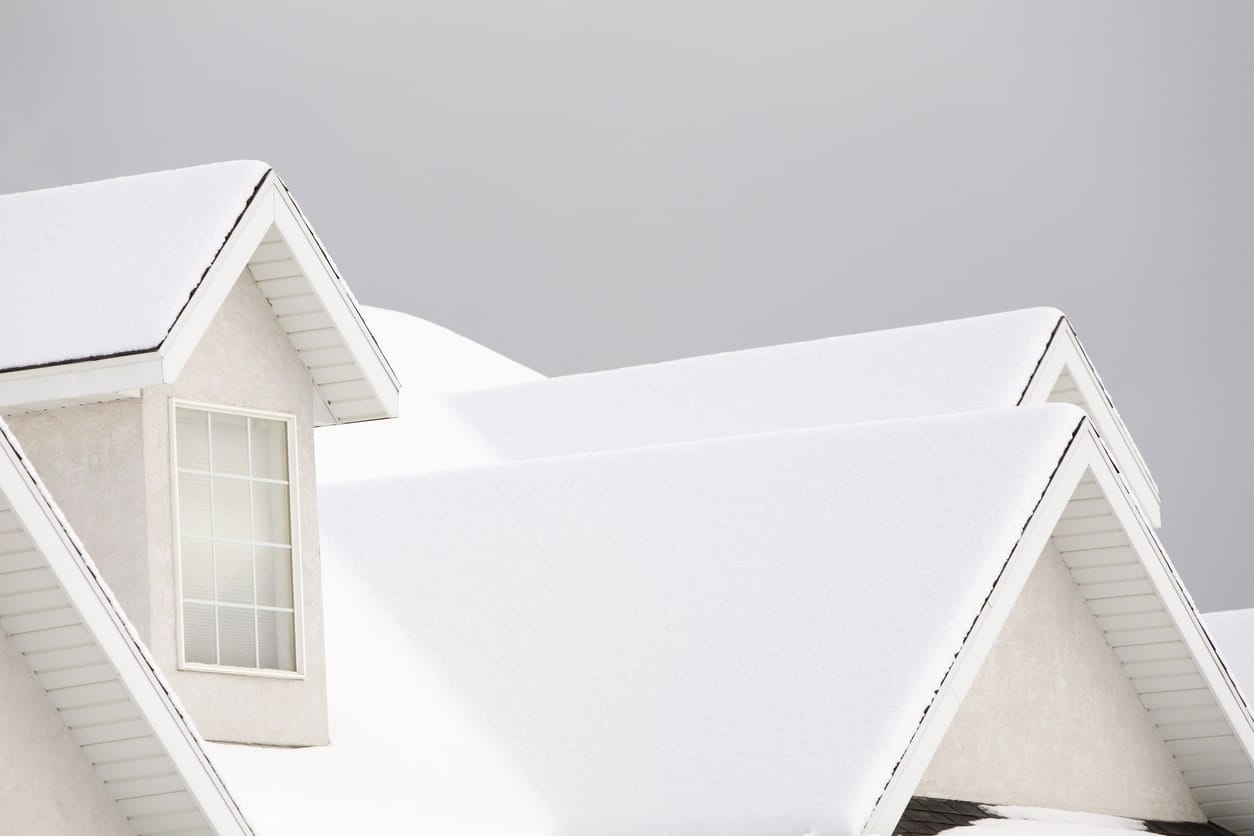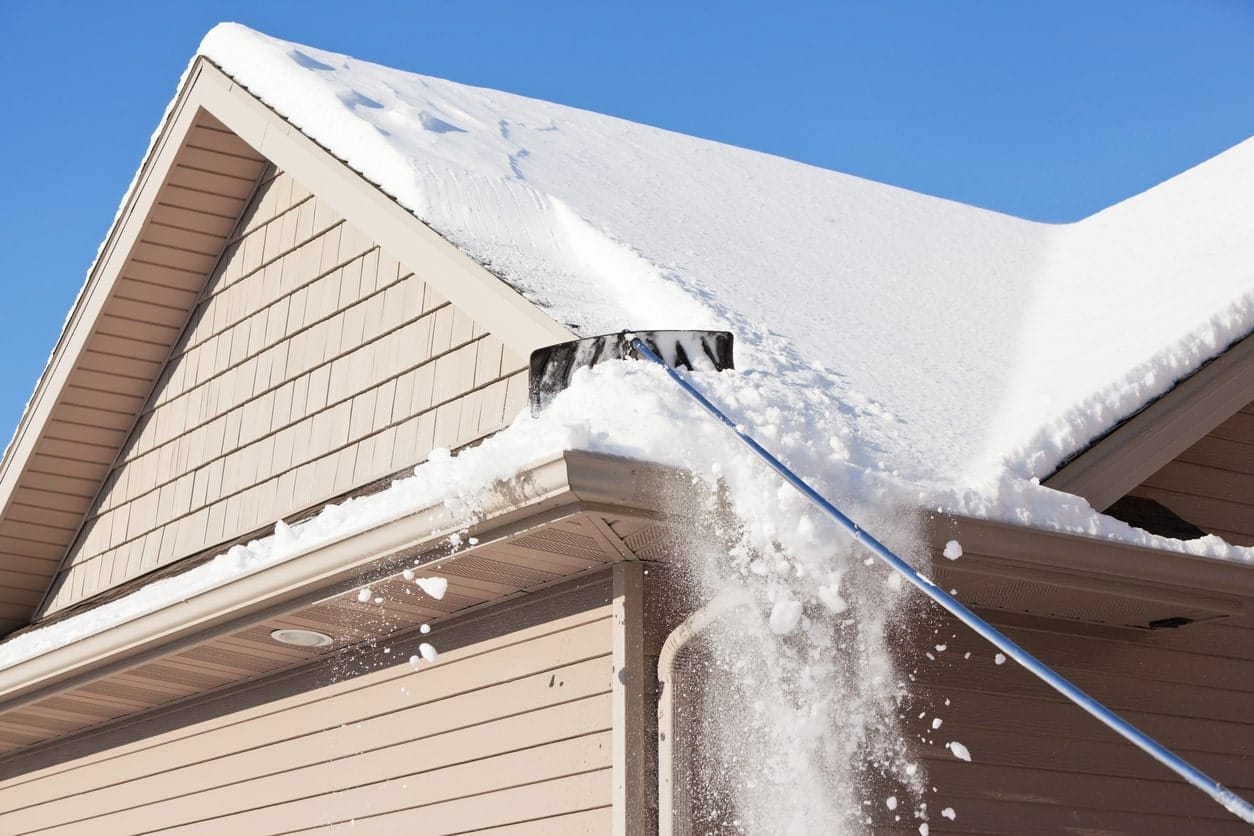Removing Snow from Roofs: 4 Techniques to Know
Snow is one of the worst enemies of your roof, luckily there are some techniques to help with removing snow from roofs, and protecting it in the future as well.
When left to collect on your roof, it causes all kinds of damage that’s costly to replace.
What do you do when snow lands on your roof?
Here are some of the most effective ways of removing snow from roofs, and ways of protecting it against snow damage.
Why Is Snow Such A Problem?
When you think of issues your roof faces, you’ll think of storms blowing tree branches onto the roof and knocking shingles off, or even punching holes through it.
Snow, on the other hand, doesn’t seem to be much of a problem.
What is it about snow that makes it such a danger to your roof?
– Water Damage
The problem is when your roof collects snow, which then melts but has nowhere to go.
The more water on your roof, the higher the risk of mold and mildew is.
If left unchecked for long enough, the water will get under the shingles and into the timbers of your roof, causing problems.
Rot can set in, which damages the roof and if left long enough, will lead to a roof replacement.
– Ice Dams
Then there’s the issue of ice dams. When snow falls on your roof, it will eventually start to melt off.
In a perfect system, the snow will melt into the gutters, where they will direct the water away from your house.
However, sometimes this isn’t what happens.
- The heating from your home causes water to melt and run down to the gutters, where heat from the home can’t reach.
- The water then freezes in the gutters, stopping more melted snow from escaping.
- It refreezes and causes overflow, again risking water damage to your roof.
– Weight
Finally, there’s the issue with the weight of snow on your roof.
In most cases, you’ll never see a problem with weight.
That’s because if your roof is up to code, then you won’t see any damage to your roof.
However, if you experience an unusually heavy snowfall or your roof isn’t as sturdy as it should be, it can cause damage.
If you notice your upstairs interior doors are sticking, that’s a warning sign that the snow needs to be removed from your roof.
Removing Snow from Roofs (and How to Prevent Damage)
So you don’t want to experience damage to your roof due to snow.
What can you do?
There are several ways you can help with preventing snow from collecting, and removing snow from roofs safely.
Here’s a few methods you should consider before the colder weather comes around.
1. Insulate Your Home
Firstly, you’ll need to look at the insulation in your roof.
Ice dams often come about because the insulation isn’t enough to stop heat escaping your home.
When the heat comes through the roof, it melts snow which then refreezes in the guttering.
Now is the time to see if your insulation needs to be improved.
Take a look at it now, and you’ll see if it needs to be replaced.
In some cases, you can find assistance in insulating your roof, so take a look around to see what help is available.
2. Install Gutter Guards
You’ll have heard of regular gutter guards that are designed to keep leaves out of your gutters.
These are vital as they stop them getting clogged and overflowing onto your roof.
Did you know that you can buy versions that are designed to stop ice, too?
These gutter guards are heated, so when snow melts into the gutters, it can’t freeze up again and cause a blockage.
It stays warm, so it flows away easily and doesn’t cause any problems.
Now’s the time to install these guards on your home, so you can avoid ice dams forming.
3. Snow Brushes
If you’re worried about the weight of snow on your roof, then you can buy brushes that are designed to help you brush it off your roof.
They usually come with telescopic handles so you can reach every part of your roof without worry.
A word of warning, though:
If you’re removing snow from roofs, you should only do it from the ground.
It’s dangerous to get up on a ladder with snow and ice, so don’t risk it if you can’t get the snow off from the ground level of your home.
4. Call In An Expert
Finally, your last option is to call in a roofing expert to come remove the snow from your roof.
They’re able to access your roof safely, so it’s often much better to get them to do it, rather than attempting it yourself.
As well as this, they will be able to get every bit of snow off the roof, so there will be nothing left to cause any damage to your home.
What Happens After The Snow?
After the bad weather has subsided, it’s a good idea to inspect your roof, looking for any damage that may have occurred.
If you’ve followed the advice in this article, then you shouldn’t be up against anything much.
However, it’s always a good idea to check.
- Get up on a ladder and take a look at the shingles. Have any come loose or are now missing? You’ll need to replace them ASAP. It’s usually a good idea to keep some shingles when you replace your roof, so you can easily grab some shingles that match your roof and replace them.
- Check that there’s no ice in the gutters that’s causing ice dams and overflows. If you’re getting icicles on your gutters, that is a sign that they’re overflowing. If you’ve bought heated gutter guards though, this shouldn’t be a problem.
- Get into your attic and take a look at your roof from the inside. If you see any moisture, there’s a leak somewhere in your roof that will need to be addressed.
With this guide, you can avoid the damage that snow brings to your roof. You also know the safety precautions to take when removing snow from roofs.
Install heated gutter guards, and check your roof to ensure that it’s in good condition.



